 Abstract
Abstract
- Organizational routines are collective phenomena involving multiple individual actors. They are crucial in helping to understand how organizations behave and change in a certain period. In this paper, by regarding the individual habits of multiple actors involved as fundamental building blocks, we consider organizational routines from an 'emergence-based' perspective. We emphasise the impacts of connections or network topologies among individual actors in the formation of organizational routines, and carry out a multi-agent based simulation analysis of organizational routines on complex networks. We consider some important factors such as inertia resulted from individual memories, component complexity of organizational tasks, turnover of individual actors, the impacts of both heterogeneity and improvisation of individual actors involved, and the dynamical properties of the network topologies within which individual actors are located. The results of our research show that network topologies among individual actors do determine the dynamic characteristics of organizational routines. Although the fact is that the mechanisms beneath this are also influenced by some main factors like the memory capacity of individual actors and the component complexity of organizational tasks that these individual actors should deal with repetitively, and that the total costs for the organization to bear during their implementation of organizational tasks are variant, the routine system on scale-free networks can always have a better performance, and obtain a much higher coherency and routinization level of collective behaviours, even in the case of turnover of individual actors. In addition, when individual actors involved are heterogeneous, the routine system on scale-free networks would also exhibit a strong anti-disturbance ability, no matter whether there are minor improvisations from these individual actors or not. Nevertheless, a large number of improvisations enable individual actors to act in some more individualistic manners, and destroy the routine system as a result.
- Keywords:
- Organizational Routines, Connections, Complex Networks, Multiple Actors, Individual Habits, Multi-Agent Based Simulation
 Introduction
Introduction
- 1.1
- Recent research indicate that routines play a crucial role in helping to explain the behaviour of organizations, and are key to understanding how organizations accomplish their work. According to Feldman and Pentland (2003), organizational routine is defined as some 'recognizable, repetitive patterns of interdependent actions, carried out by multiple actors'. Many scholars have yet focused on the role of these multiple individual actors (Abell et al. 2008; Feldman & Pentland 2003), their psychological properties such as procedural and declarative memories (Cohen & Bacdayan 1994; Lazaric 2008), motivations and incentives (Grave 2008), experiences (Turner & Fern 2012), etc., during the performance of a routine. Becker (2004) and Hodgson (2008) argued that there is an essential relationship between individual actors and the collective routines they are involved in. Organizational routines emerge from interactions between individual actors (Bapuji et al. 2012). They are not just simply followed or reproduced; rather, individual actors 'have choices between whether to do so, or whether to amend the routine' (Becker 2004, 2005; Feldman 2000; Feldman & Pentland 2003). However, individual actors involved in organizational routines may be located in different places and belong to different organizational units. Their acts depend on their own knowledge contexts and capabilities, as well as the roles they play while performing organizational routines (Becker 2004; Feldman & Pentland 2003). In other words, all of these individual actors involved in organizational routines are distributed and heterogeneous, connecting with each other through communications.
- 1.2
- Feldman and Rafaeli (2002) and Turner and Rindova (2012) pointed out that the connections formed in the process of performing organizational routines – which enable the transfer of information among individual actors – contributed to the development of common understandings and agreements regarding the performance of routines in practice; this in turn contributed to both the stability and adaptability of organizational routines. However, relatively limited attention has been paid to the question of how these connections among individual actors affect routine performances.
- 1.3
- Miller et al. (2012) presented multi-agent based simulation as a method of modelling micro-foundations of organizational routines. Their work identified three kinds of memory – procedural, declarative, and transactive – to explain routine dynamics. However, they did not consider the connections or network topologies among individual actors which, from the perspective of complex networks theory (Barabâsi et al. 1999; Dorogovtsev & Mendes 2003; Watts 1999), play a crucial role in determining the dynamic properties of routine systems.
- 1.4
- In this paper, we appraise organizational routines through a 'bottom-up' approach, and investigate their evolutionary trajectories on complex networks. By regarding the habitual behaviours of individual actors (namely, the individual habits of multiple actors involved in organizational routines) as 'fundamental, individual-level building blocks' (Hodgson 2008; Knudsen 2008; Gao et al. 2014), we consider routines as spontaneous emergences from repeated interactions that individual actors engage in on an 'increasingly habitual basis' (Witt 2011), and build up a multi-agent based simulation model to formulate this process. Some important factors such as inertia resulted from individual memories, component complexity of organizational tasks, and turnover of the individual actors. These factors, as well as the impacts of both heterogeneity and improvisation of the individual actors involved, and the dynamical properties of the network topologies within which individual actors are located, are all considered in our simulation model.
- 1.5
- From the simulation results of variant concrete situations, we conclude that network topologies among individual actors do determine the dynamic characteristics of organizational routines. We observed that for all the different combinations of both the memory capacity of individual actors and the component complexity of organizational tasks that these individual actors need to deal with repetitively, the total costs that the organization bears for the performance of organizational tasks vary. However, the routine system on scale-free networks can always perform better, and obtain a much higher coherency and routinization level of the organizational routines, even in the case of individual actors' turnover. In addition, we found that when individual actors involved are heterogeneous, the routine system on scale-free networks exhibit a strong anti-disturbance ability and achieve a relatively stable, higher routinization level of collective behaviours over time, regardless of whether or not there are minor improvisations from these individual actors. Nevertheless, a large number of improvisations enable individual actors to act in more individualistic manners, which may destroy the routine system. Thus, a better balance is required for the emergence of a routine system through all the levels of the crucial factors previously mentioned.
- 1.6
- The rest of this paper is structured as follows. In the second section, we provide a brief overview of literatures related to our work. Based on a summary of the relationship between the two main aspects of organizational routines, the ostensive and the performative, we take individual habits as the basic units of analysis, and discuss some of the characteristics in network topologies inherited from the individual actors involved in organizational routines. In the third section, we build up a multi-agent based simulation of organizational routines through a 'bottom-up' approach. Through an analogy between the individual actors involved in organizational routines and a specific type of active agents, we offer a multi-agent based simulation model via Swarm package (Swarm development Group [SDG] 2000), and achieve the visualization and reproduction of both the ostensive and performative aspects of organizational routines with the aid of computer tools. Next, we present the simulation results for variant concrete situations, and discuss factors such as the network topologies of the individual actors, their memory capacity and the component complexity of organizational tasks, and both the turnover and improvisations from individual actors involved, that do have impacts on the evolution of organizational routines. The last section includes our conclusion and discussion.
 Theoretical
foundations
Theoretical
foundations
-
The ostensive and performative aspects of organizational routines
- 2.1
- As collective phenomena that involve multiple individual actors, or the generative system conceptualised by Feldman and Pentland (2003), it has been widely accepted that there are mainly two aspects in organizational routines (Feldman & Pentland 2003; Pentland & Feldman 2005). The first is the ostensive aspect that shapes our perception of what the term 'organizational routine' should refer to. It constitutes sets of particular, overlapping narratives or functional events which refer to the 'abstract patterns' of action, or the 'ideal/schematic form' of the routines, and provides road maps for individual participants to carry out their organizational tasks (Pentland & Feldman 2007, 2008). The second is the performative aspect that represents the specific (actual) performances taken by specific people, at specific times, in specific places (Pentland & Feldman, 2005). Pentland and Feldman (2005, 2008) argued that these performances are particular sequences of events experienced by the individual actors involved in the routines.
- 2.2
- However, there is a recursive relationship between the two
aspects. On one hand, the specific performances of individual actors
create and recreate the ostensive aspects (namely, the narrative
networks) of the routines. On the other hand, the ostensive aspect
constrains and enables the performances in practice. These two aspects
mutually constitute an organizational routine as a whole (Feldman & Pentland 2003),
as shown in Figure 1.

Figure 1. Internal structure of organizational routines - 2.3
- Here, we define the term 'narrative network' as a collection of functional events that relate to each other through 'their sequential occurrence in a story or set of stories' (Hendricks 1972, 1973). Pentland and Feldman (2007, 2008) indicated that the narratives as the basic nodes within a narrative network are indeed some fragments of stories, while connections between these fragments (namely, ties with the narrative network) imply their sequence or relationship in occurrence. As a whole, the narrative network can be regarded as 'an explicit representation' of the ostensive aspect of an organizational routine (Pentland & Feldman 2008).
- 2.4
- In addition, there are individual actors involved in every
narrative, ranging from a few to several hundreds or even more. These
individual actors may work together or communicate with each other,
sharing information and knowledge about their organizational tasks. Put
simply, individual actors involved in narratives are interconnected
through certain relationships.
From individual habits to organizational routines
- 2.5
- Organizational routines emerge from repeated interactions between individual actors engaged in the implementation of organizational tasks. Becker (2004) argued that the personal behaviours of these individual actors are inherently habitual. That is, they have tendencies to behave or think in a particular way 'in a particular class of situations', and 'repeat the same act in similar material conditions' (Felin et al. 2012; Hodgson 2008). However, such a tendency 'may, or may not, be expressed in current behaviour or thought', depending on the presence of an appropriate stimulus or context (Knudsen 2008). That is, a habit is not necessarily used all the time, but may be triggered by a certain cue. In this sense, we can view a habit as 'a subset of actual behaviours or thoughts that realised from a larger set of possible behaviours or thoughts in a particular class of situations' (Hodgson 2004; Knudsen 2008).
- 2.6
- Knudsen (2008) and Bapuji et al. (2012) considered habits of individual participants as the fundamental building blocks from which organizational routines emerge, while organizational routines are special structures that operate through the triggering of these interlocking individual habits (Hodgson 2008). Weick's (1990) work of the documentation of a historical airplane disaster showed that organizational routines may be disrupted when all the individual actors involved act in more individualistic – rather than collective – manners. Thus, Becker (2004) pointed out that a fine balance 'between individual habits of the actors and organizational routines' needs to be maintained so as to avoid the breakdown of organizational coordination.
- 2.7
- However, these habitual behaviours of individual actors are
not always stable. Witt (2011)
argued that as both the factual and procedural knowledge of routines is
shared and its meaning is often socially constructed, individual actors
involved in organizational tasks are not entirely autonomous; they are
also influenced by their nearest neighbours and/or the environment in
which they are located. During the repetition of actions, even a very
small novelty may lead to the development of another absolutely
different pattern of behaviours among the individual actors, and result
in the emergence of new routines at the organizational level (Hodgson 2008; Witt 2011).
Network topologies for individual actors involved in the routines
- 2.8
- Hodgson (2008) argued that individual habits are not developed in isolation, but emerge within social life. That is, individual actors may interact with each other through certain relationships in the performance of organizational tasks. If we use the nodes to represent the distributed and heterogeneous actors involved in organizational routines, and the edges connecting the nodes to refer to the connection between corresponding actors, then the connectivity structure of the individual actors can be characterised by a number of topological properties of networks which play a fundamental role in determining the systems' dynamic properties (Barabâsi et al. 1999; Dorogovtsev & Mendes 2003; Watts 1999). Typically, two measures are adopted to characterise structural properties of the networks. One is the average path length, measuring the average separation between two nodes in the graph; the other is the clustering coefficient, which indicates the probability that two nearest neighbours of a node are also nearest neighbours of each other.
- 2.9
- Four typical but different network topologies are considered in this paper, namely, regular or lattices, random networks, and small-world and scale-free graphs. These different network topologies may share the same number of individual actors (i.e. nodes), but differ in terms of the pattern of connections.
- 2.10
- Regular: A regular network is defined as a nearest-neighbour coupled network in which every node is only joined by a few of its nearest neighbours, and the distances of these connections do not exceed a given value. This type of network topology is clustered and covers long average path lengths. In this paper, a 2-D lattice is used.
- 2.11
- Random: The random network is placed at the opposite end of the spectrum from the regular network, where connections between nodes are not limited to the immediate neighbours, but randomly drawn from the entire population (Erdös & Rényi 1959). Thus, the nodes own short average path lengths and are not clustered.
- 2.12
- Small-world: A small-world network can be created from a regular lattice by randomly rewiring each of the links between individual actors with some probability p (Watts & Stogatz 1998). The rewiring aims at substituting some short-range connections with long-range ones, which may drastically reduce the average distance between randomly chosen pairs of nodes, and produce a small-world phenomenon characteristic to many social networks (Milgram 1967). Small-world networks are highly clustered and have relatively short minimum path lengths.
- 2.13
- Scale-free: A scale-free network is characterised by its connectivity distribution, which is in a power-law form κ−r, independent of the network scale (Barabâsi et al. 1999). This power-law distribution, in comparison with the familiar Poisson distribution obeyed by connection sequences of both the random and small-world networks mentioned previously, falls off more gradually, allowing for 'a few nodes of very large number of links' to exist (Wang & Chen 2003), but most nodes have 'only a few incoming or outgoing links' (Jeong 2003). Because of this, we affirm that the scale-free network owns a smaller average path length and a typically larger clustering coefficient.
 Development
of the multi-agent based simulation model
Development
of the multi-agent based simulation model
-
Design of the agents
- 3.1
- Our simulation model comprises four kinds of agents, namely actions, individual actors, narratives, and the environment, as discussed further.
- 3.2
- Actions: In this paper, we regard
actions involved in organizational routines as particular kinds of
agents that provide particular ways for individual actors to perform
their organizational tasks. For every performance of the routines, some
of these actions are selected and adopted by individual actors to
dispose off their organizational tasks. We assume that these action
agents possess at least three of the following basic attributes.
- actionID: A unique ID number for definite identification of each action agent.
- actionType: The coefficient actionType is used for discriminating the performance outputs between different action agents. In our simulation model, however, we just assign this attribute of the action agents with some constant values which refer to certain narratives that may occur subsequent to the present ones and indicate the event sequences of the stories called organizational routines.
- actionCost: The performance of actions related to organizational tasks involves essential expenses such as material and human resources, money, time, and so on. Here, we only take the coefficient actionCost to represent all the expenses borne for each action performed in the routines.
- 3.3
- Individual actors: Based on the
discussion in the section entitled 'From individual habits to
organizational routines', we suppose that each individual actor agent
in our simulation model owns a unique ID number (actorIDNum)
for definite identification and the following four basic attributes:
- A general goal of actions (G). All the individual actor agents involved in the organization have a general goal of actions (G). For example, under the hypothesis of limited rationality (Simon 1945), it may be expected for their actions to cost minimum possible expenses. This general goal (G) determines the actions chosen for individual actors from their possible action sets each time when performing their organizational tasks.
- A set of possible actions (S).
As there are possibly various but limited ways for individual actors to
perform their organizational tasks, we use a set S
to represent the collection of possible actions that individual actors
may or may not choose in a particular class of contexts.
S = {action1, action2, …, actionn} (1) Here, the size of the set S – i.e. n in formula (1) – refers to some capacities of individual actors, and each of the element actioni (i = 1, 2, …, n) represents a certain action agent that indicates a particular way for individual actors to handle their organizational tasks.
- A list of habits (H).
For treating individual habits as dispositions, we use a specific set
of conditional probabilities (H)
– the probability that 'a particular behaviour will occur in response
to a stable contextual cue' (Knudsen
2008) – to explicitly express the concept 'individual habits'
in our simulation model.
H = {p1, p2,…,pn} (2) The coefficients pi refer to the conditional probability for individual actors to take a certain action actioni as their repetitive actions in response to certain stimuli (Ωs) from environments:
pi = p(actioni|Ω), (i = 1, 2,…, n) (3) - A list of memory (M).
Miller et al. (2012)
emphasised the importance of (individual) memory in both the formation
and persistence of routines, and argued that 'over time, as individual
agents discover and remember successful actions', the need to search
may be reduced or eliminated, thereby improving efficiency and
'producing recognizable, repeated problem-solving patterns'. In this
paper, we use the 'first-in-first-out' (FIFO) stack
with a fixed length (memoryLength) to represent
memory of individual actors (M).
During each repetition, some actions occur in accordance with the
individual actors' list of habits (H).
These actual actions are then added to the memory list (M),
which would affect the probability values of the habits (H)
in the following performances. If we take the variable performNumi
to denote the actual number of occurrences for each action agent actioni
stored in the memory list (i = 1, 2, …, n),
then we can observe the relation that:

(4)
- 3.4
- Figure 2 provides a
sketch of the primary interactions between these four main attributes
of the individual actor agent.

Figure 2. Internal structure of the 'individual actor' agent - 3.5
- Figure 2 shows the
following: every individual actor agent responds to the particular
situations of the environment in accordance with his/her goal of
minimizing the performance expenses of organizational tasks. That is,
individual actor agents are expected to seek and/or imitate their
neighbours to derive a more cost-effective approach. As a result, a
certain action may be selected from the possible action set S,
and be adopted to cope with the work that the individual actor agents
are entrusted with. Then, within a stable context, these individual
actor agents repeat particular actions, and gradually evolve their own
habits through the reinforcement of memory.
Narratives
- 3.6
- Narratives are considered as a type of agent that
represents some cognitive regularities and/or expectations individual
actors use to 'guide, account for, and refer to specific performances
of a routine' (Feldman &
Pentland 2003; Pentland
& Feldman 2005). According to Pentland and Feldman (2007), each narrative agent
comprises several individual actors and certain kinds of actions that
occur with them. The following are some main attributes:
- narrativeID: a unique ID number for definite identification of each narrative agent.
- A list of individual actor agents (actorList): we use a set named actorList to represent a collection of individual actor agents that are involved in each narrative. All these individual actor agents are distributed on a 2-Dimension Raster, interacting with each other and performing the given organizational tasks together.
- A list of action agents (actionList):
This actionList in the simulation model denotes a
collection of action agents that are possibly selected by individual
actor agents to process their organizational tasks. The size of this
collection of action agents (actionNum) indicates
the number of different approaches that these actor agents are
permitted to adopt, which Wood (1986)
labelled in his work as 'component complexity' of the organizational
tasks.
We observe that every individual actor agent's set of possible actions are indeed a subset of the collection of action agents actionList of the narrative agent that he/she belongs to. That is, n ≤ actionNum, and S ⊆ actionList. - A cost coefficient (narrativeCost): We use a variable narrativeCost to evaluate the narrative agent's performance, which denotes the total expenses that all the individual actor agents should expend at a time.
- 3.7
- Further, we use a first-order Markov matrix (T)
(Pentland et al. 2010)
to describe explicitly sequential adjacencies between these different
narrative agents, as shown in the following figure:

(5) - 3.8
- Here, the subscript variable m in
formula (5) denotes the number of narratives that are involved in the
routine. The element wij
indicates the connection probability from narrative i
to narrative j, which numerically equals the
proportion of individual actor agents engaged in narrative i
that adopt the action related to narrative j as
their current approach in performing the organizational tasks (1 ≤ i,
j ≤ m). Thus, the values of
these coefficients satisfy the following conditions:

(6) - 3.9
- The matrix T shows a specific structure
of the narrative network, and gives us an integral description of the
possible frequencies of event-sequences (that is, transitions from some
narratives to others) that exist in practice. Based on Pentland's (2003) fundamental work, we
use the Euclidean distance (D) of the observed
action network from a uniform, random network for describing the
variation of the actual behavioural sequences during performance of the
routines:

(7) Here, the variable D's range of value is 0 to (m − 1), demonstrating the routinization level of organizational behaviours. That is, larger values of the variable D may reflect less variety of the narrative network, and vice versa.
The environment
- 3.10
- Cohendet and Llerena (2003) and Howard-Grenville (2005) pointed out that organizational routines are essentially context-dependent, and that their performances are often embedded in specific environments. It is the environment that offers a specific context within which individual actor agents are located and interact with each other. Although it has been widely recognised that changes in environment are common occurrences for today's organizations, and there are a few literatures on organizational routines in dynamic environments (Gilbert 2005; Grote 2009; Howard-Grenville 2005), we still know little about micro-mechanisms underlying the question of how individual actors' understanding and performance of the routines are affected by the organizational environment (Kozica et al. 2014).
- 3.11
- In this paper, we assume that the environment is relatively
stable during the simulation process, and treat it as a constant agent
that provides fixed conditions for individual actors to act and
interact with each other in performing their organizational tasks. That
is, for each simulation tick, some specific stimuli are always
existent, repetitively invoking related action agents for individual
actors to perform their organizational tasks.
Variation activities of actions in performance of the organizational tasks
- 3.12
- Some literature from both empirical and simulation research (Aarts & Dijksterhuis 2000; Cohen & Bacdayan 1994; Hodgson & Knudsen 2004; Wood & Neal 2007; Yin et al. 2004) have shown that it is repetition that immediately causes the formation of individual habits. With repetition, the control of behaviour of all the individual actors involved in organizational routines may shift 'from cognitive mechanisms to an automatic mode' (Knudsen 2008), and a persistent habit gradually emerges.
- 3.13
- Nevertheless, in the repeated performance of organizational tasks, individual actors may vary their habitual behaviours to achieve their primary goals (i.e. minimizing the operational expenses of their actions). First, when confronted with new organizational tasks, individual actors with limited capacities have powerful incentives to search (from the set of possible actions) for new alternatives with low expense to substitute their current actions (Hodgson 2008; Knudsen 2008). However, when all operations function well, this search for alternatives will stop, and 'the current way of doing things is repeated' (Grave 2008; Winter 2003). In addition, immediate or delayed rewards (in our example, referring to the lesser expense that individual actors must be paid) may reinforce the repetition of the given actions (Knudsen 2008; Postrel & Rumelt 1996). In our simulation model, we take every simulation tick to represent a certain performance of the routine, and formulate this mechanism as follows: at each simulation tick, individual actor agents decide whether to search for new alternatives randomly. If the searching activity does occur, the individual actor agent searches from his/her collection of possible actions for another different action with a much lesser expense than the current one (if this action exists, of course) as his/her new alternative in the next performance. Otherwise, there is nothing the individual actor agent should do.
- 3.14
- Second, individual habits may be replicated through imitation (Hodgson 2008). The fact is that within a relatively stable context, individual actors may imitate some particular actions of their neighbours either consciously (e.g. duplicating their neighbour's action of lesser expense) or unconsciously (e.g. reproducing an action that is popular among their neighbours). Hence, some specific actions are propagated and reinforced by recurrent performances as this can intensify familiarities, and the habits giving rise to them are replicated as well (Schulz 2008). As a result, these imitation activities may bring about changes of habits (H) as well as the memory (M) of individual actors, or even mutation of organizational routines. We represent this mechanism in our simulation model as follows: at each simulation tick, an individual actor agent decides whether to imitate his/her neighbours in an apparently random manner. If the answer is 'Yes', then the individual actor agent selects one of his/her neighbour agents randomly, and reproduce that neighbour's current action as the alternative in the next iteration if it exhausted a lesser expense than his/her own.
- 3.15
- Figure 3 gives an
overview of the procedure that an individual actor agent goes through
in the completion of his/her variation activities.

Figure 3. Flow chart for action searching and/or imitation activities - 3.16
- However, the imitation activities of the individual actor
agents are often also influenced by the behaviour of their neighbours.
That is, as previously mentioned, individual actor agents are inclined
to adopt the actions that are popular with their neighbour agents, as
well. To depict this situation, for each individual actor agent actori
(i = 1, 2, …, actorNum, where
the parameter actorNum denotes the total number of
actor agents that participated in each of the narrative agents), we let
cActionCosti denote the
expense that he/she should undertake in performing the current action (actionCost)
and neighborListi to denote
the collection of his/her neighbour agents, and define a cost function
for this individual actor agent in the performance of organizational
tasks, as shown in the following:

(8) - 3.17
- Here, the coefficient δi is a penalty coefficient, representing the degree of differences between the current action of the individual actor agent actori and that of their neighbour agents. In this paper, we assume that the value of δi is equal to the number of neighbour agents from neighborListi who currently adopt actions different from the one that is employed by the individual actor agent actori (i = 1, 2, …, actorNum).
- 3.18
- Then, for each narrative agent narrativej
(j = 1,2, …, m),
we describe the attribute parameter narrativeCost
as follows:

(9) - 3.19
- Here, the coefficient actorListj represents the collection of individual actor agents participating in the narrative agent narrativej (j = 1, 2, …, m).
- 3.20
- Thus, we use a variable totalCost to
describe the performance efficiency of the routine, which equals the
sum of all the values of the coefficient narrativeCost
of the narrative agents:

(10) Construction of the simulation model via Swarm package
- 3.21
- The multi-agent based simulation model was constructed using Swarm package (Swarm Development Group [SDG] 2000). The code is available at https://www.openabm.org/model/4468/version/2/view
- 3.22
- The Unit Testing method is used for verification of the simulation model. North and Macal (2007) argued that 'it can be a powerful way to test and retest code'. By conducting tests first on each function or method, then on each module, then on each area, and finally on the entire system, we make sure that the specifications are complete and that there are no mistakes made in the construction of the multi-agent based simulation model. In addition, the Specific Scenarios Testing method, which Gilbert (2008) viewed as a very weak yet effective way for verification and validation of multi-agent based simulation, is also used for validation of the simulation model. Through the test and analysis of a series of simple scenarios, we affirm to some extent that our simulation model is valid.
- 3.23
- We suppose that there are 12 narrative agents involved in
the routine (m = 12), each consisting of a number of
action agents and individual actor agents, as well. All the individual
actor agents participating in a narrative are distributed on a
2-dimension lattice. For analysis of the organizational routine on
complex networks, two classical models from the complex networks theory
are employed in our study. The first is the WS model (Watts & Stogatz 1998),
which is adopted to generate the regular lattice, random network, and
the small-world by setting the rewiring probability p
equals to 0, 1 and a very small value in the interval (0, 1),
separately. The second is the BA model (Barabâsi
et al. 1999; Barabâsi
& Bonabeau 2003), which is adopted to generate the
scale-free network via two important mechanisms (i.e. random growth and
preferential attachment). We started with an initial set of three fully
connected nodes (namely, the coefficient in the BA
model n0 = 3), and let the
degree of the new added vertices equal 3 (that is, the coefficient in
the BA model m0
= 3). As a result, we obtained the four typical but different kinds of
network topologies shown in Figure 4.

Figure 4. Four typical connections/network topologies used in simulation
 Simulation
results
Simulation
results
- 4.1
- We discuss our simulation results in four stages. First, we compare the evolutionary trajectories of the organizational routine on the four typical but different kinds of network topologies mentioned in the section entitled 'Network topologies for individual actors involved in the routines' (namely, regular lattice, random, and small-world and scale-free networks, as shown in Figure 4).
- 4.2
- Second, we identify two important factors that affect the formation of organizational routines. The first is the memory capacity of individual actors, which we represent by the length of the memory list (memoryLength). The other is the component complexity of organizational tasks, represented by the number of actions that need to be executed in the performance of the routine (actionNum).
- 4.3
- Third, in order to analyse the influence of turnover on individual actors, we suppose that at every simulation tick, individual actor agents may leave the organization randomly with a given probability turnover_P (0 ≤ turnover_P ≤ 1). However, to facilitate easy discussion, we assume that the total number of individual actors involved in the routine remains unchanged during the simulation process. That is, new participants would join the organization, filling in locations of the individual actor agents who have left.
- 4.4
- Fourth, we consider the role of both heterogeneity and improvisation of individual actors in the performance of the routines. First, when individual actors involved in organizational routines are heterogeneous, it means that all the individual actors possess variant memory capacities (that is, with different values of the coefficient memoryLength), and deal with organizational tasks of different component complexities (that is, with different values of the coefficient actionNum). Second, we discuss the impact of improvisation from individual actors, based on the fact that organizational practice is inherently improvisatory, with plenty of scope for adjustments and variations that 'make it possible to get things done in diverse situations' (Pentland & Feldman 2005, 2007).
- 4.5
- (1) For the former two stages, we assume that the number of
individual actor agents (actorNum) that participated
in every narrative agent is the same (in this paper, according to the
results of sensitivity analysis technique about input parameters of the
simulation model, we let actorNum = 36), and that
both the coefficients of memoryLength and actionNum
are constants. This means that while individual actor agents possess
the same level of memory capacities, all the narrative agents own the
same number of possible actions. With default settings as shown in
Table 1 (which we call
Scenario I), we vary the value of memoryLength from
1 to 6, and that of actionNum from 3 to 8,
respectively, and execute the simulation model on all of the four types
of network topologies, each with 120 simulation ticks (representing 120
performances of the routine, iteratively), successively, arriving at
the simulation results shown in Figure 5.
Table 1: Overview of model parameters (Scenario I) Variable Default settings Description actorNum 36 Number of individual actor agents that participated in each narrative agent. actionNum 3, 8 Number of action agents involved in each narrative agent (the size of the possible action set S). m 12 Number of narrative agents constituting the routine. actionType U(1, narrativeNum) This attribute actionType refers to certain narratives that may occur subsequent to the present ones. Its value is randomly assigned with a uniform distribution U(1, narrativeNum). actionCost U(1, 9) Expense that should be paid when the related actions are being undertaken. Its value is randomly assigned with a uniform distribution U(1, 9). memoryLength 1, 6 Length of the memory list (M), referring to the memory capacity of individual actor agents. Note: underlined values are default settings of the coefficients 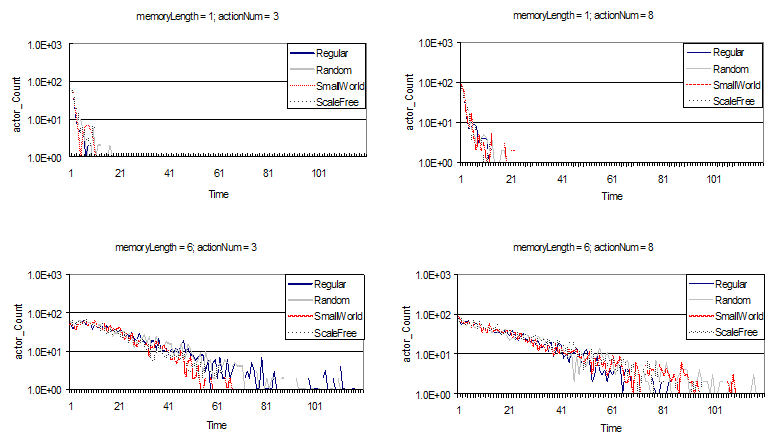
(a) The total number of individual actor agents searching for new alternatives 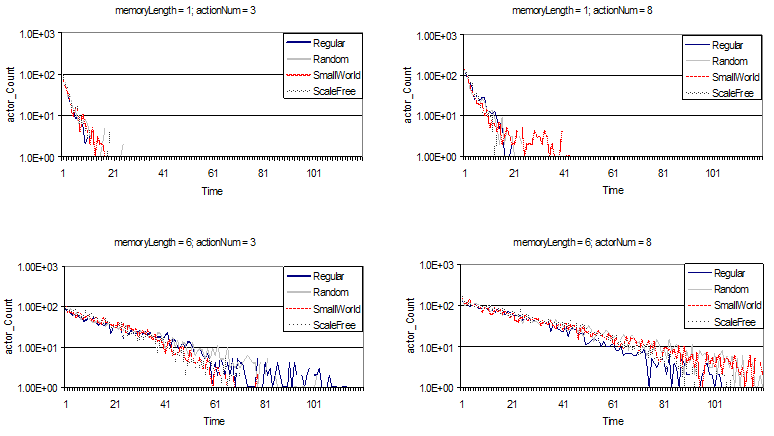
(b) The total number of individual actor agents that imitate their neighbours 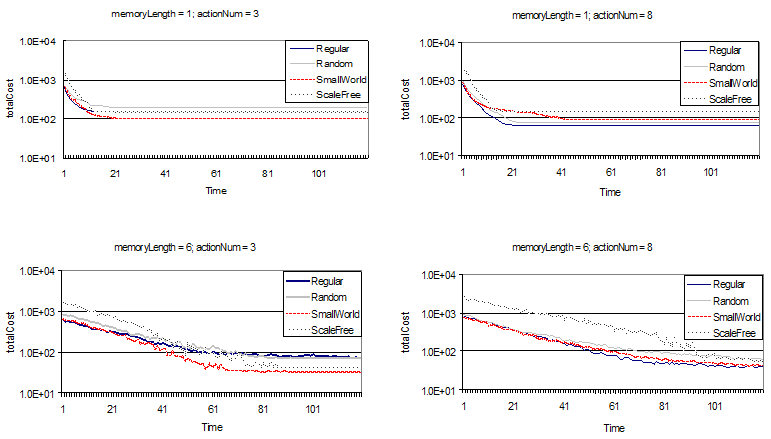
(c) Values of the coefficient totalCost 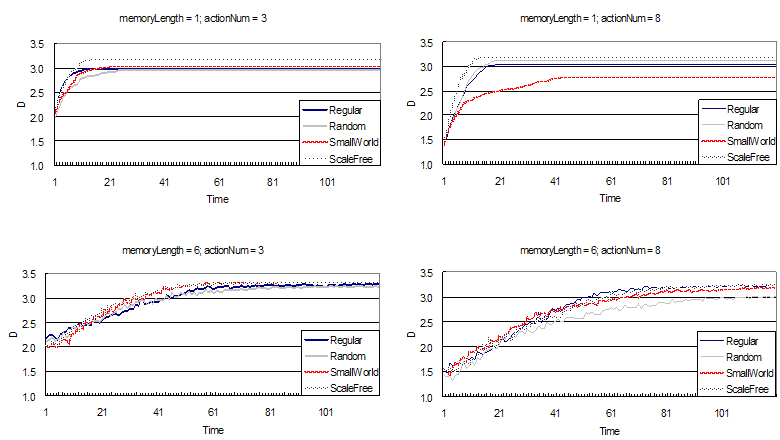
(d) Values of the coefficient D Figure 5. Simulation results with default settings for Scenario I - 4.6
- Based on the simulation results shown in Figure 5, we can state that network topologies among individual actors do impact the formation process of the routine at the organizational level. However, these impacts are closely influenced by both the memory capacity of individual actors that were involved in the routine and the component complexity of the organizational tasks to be performed. First, when confronted with organizational tasks of lower component complexity (actionNum = 3), there being less alternatives to adopt, the total numbers of individual actors both searching for and imitating activities reduces to zero quickly, and the routine system goes into a stable state. There are no significant differences between the routine systems on different network topologies, as shown in the upper-left portion of Figure 5 (a) and (b). Nevertheless, as individual memory and cognition may result in inertia among actors during their performance of the organizational tasks, individual actors with a higher level of memory capacity (memoryLength = 6), would experience this convergent tendency for a much longer period of time, relatively. The routine system on random networks is especially more reflective of this case, followed by those on regular lattice. The routine systems on both small-world and scale-free networks require a much shorter period of time for converging to a stable state, as shown in the bottom-left portion of Figure 5 (a) and (b).
- 4.7
- Second, when individual actors are dealing with organizational tasks of higher component complexity (actionNum = 8), they have to struggle between inertia of memories and some more feasible alternatives. Thus, the total numbers of individual actors performing both searching and imitation activities fluctuate with time, and the routine system would gradually maintain relatively dynamic stability. However, there are differences between organizational routines on different network topologies. On one hand, for individual actors with lower levels of memory capacity (memoryLength = 1), the routine system on small-world networks exhibits the most obvious fluctuations, as shown in the upper-right portion of Figure 5 (a) and (b). On the other hand, for individual actors with higher levels of memory capacity (memoryLength = 6), it is the routine system on random networks, as shown in the bottom-right portion of Figure 5 (a) and (b).
- 4.8
- Third, regarding the influences of network topologies on the total costs that the organization should undertake for performing the organizational tasks, we can assert from Figure 5 (c) the following: (i) For organizational tasks of lower component complexity (actionNum = 3), there being less alternatives for individual actors to adopt, the routine system on small-world networks has to pay a minimum expense, followed by the routine system on both regular and scale-free networks; the routine system on random networks bears the maximum, as shown in the left portion of Figure 5 (c). (ii) For individual actors handling organizational tasks with higher component complexity (actionNum = 8), the routine system on scale-free networks pays the most, followed by that on both random and small-world networks, and finally followed by that on regular lattices, as shown in the right portion of Figure 5 (c). (iii) When the value of the coefficient memoryLength varies from 3 to 6, the value of the coefficient totalCost fluctuates with a large amplitude due to inertia among individual actors, which results from the increase of memory capacity. However, the routine system on scale-free networks shows a much stronger sensitivity of the coefficient memoryLength, which depicts the memory capacity level of all the individual actors involved in the routine, as shown in the bottom portion of Figure 5 (c).
- 4.9
- Fourth, Figure 5 (d) shows that for all the four different situations ( relating to the four different combinations of the two coefficients memoryLength and actionNum), the routine system on scale-free networks owns the highest value of the coefficient D (representing a much more coherent routinization level of collective behaviours at the organizational level), followed by the routine system on both the regular and random networks. Nevertheless, the routine system on small-world networks displays more sensitivity to the concrete situations, as shown in the bottom-right portion of Figure 5 (d).
- 4.10
- (2) In the third stage, for analysing the influence of
turnover of individual actors during the formation process of the
routine, we let the turnover probability turnover_P
= 0.001, keeping all the other input parameters settings the same as
those for Scenario I; we called this Scenario II. Then, we executed the
multi-agent based simulation model on all of the four types of network
topologies, each with 120 simulation ticks (representing 120
performances of the routine, iteratively), successively, and obtained
the simulation results shown in Figure 6.
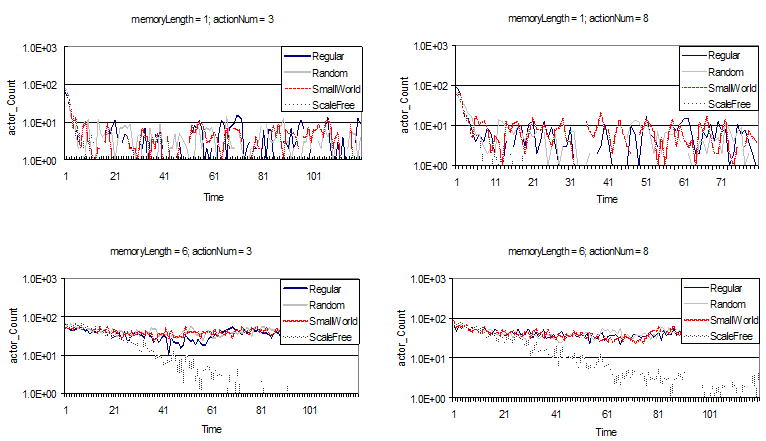
(a) The total number of individual actor agents that searching for new alternatives 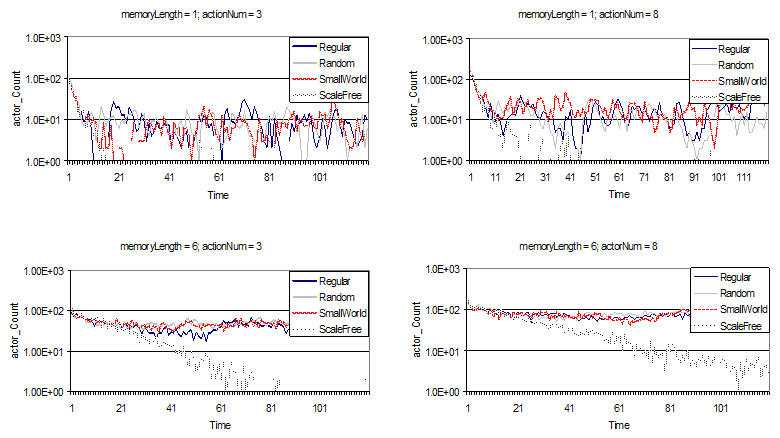
(b) The total number of individual actor agents that imitate their neighbours 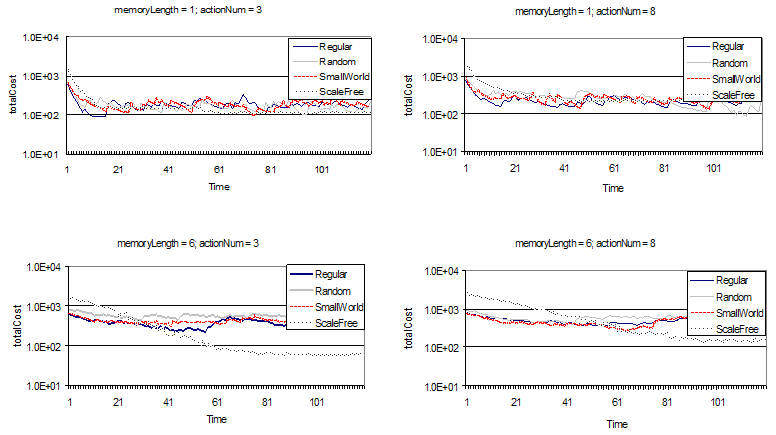
(c) Values of the coefficient totalCost 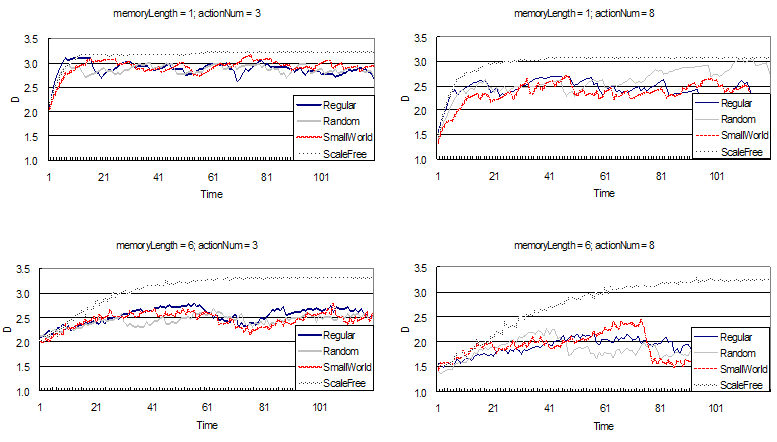
(d) Values of the coefficient D Figure 6. Simulation results with default settings for Scenario II - 4.11
- We affirmed that the turnover of individual actors would aggravate the fluctuation of the routine system on all four different network topologies. Furthermore, as shown in Figure 6, although there are subtle differences between combinations of different values of both the coefficients memoryLength and actionNum, we were still able to derive some general patterns from the simulation results. That is, compared to the vibration of the routine system on the other three kinds of networks (namely, the regular, random, and small-world networks), the routine system on scale-free networks tends to converge over time and eventually reaches a stable state. Essentially, it can more effectively cope with fluctuations resulting from turnover of individual actors. Furthermore, inertia as a result of memory capacity of individual actors exacerbates this phenomenon, as shown in Figure 6 (a) and (b).
- 4.12
- Further, with the simulation continuing, the routine system on scale-free networks owns a relatively lower value of the coefficient totalCost (with an exception only of the situation when memoryLength = 1 and actionNum = 8, as shown in the upper-right portion of Figure 6 (c), where there are no significant differences between the routine systems on the four distinct network topologies), but a higher value of the coefficient D. This means that the routine system on scale-free networks is easier to achieve at a much more coherent routinization level of collective behaviours at the organizational level, and the expenses are relatively minimal.
- 4.13
- (3) In the fourth stage, we differentiated the initial values of both the coefficients memoryLength and actionNum for each of the individual actor agents, to consider the role of heterogeneity of individual actors in performance of the routines. Then, to discuss the impact of improvisation from individual actors, we introduced a coefficient improvi_P (0 ≤ improvi_P ≤ 1) to describe the improvisation activity probability of individual actor agents. When improvisation occurs, the particular courses of action (namely, the way that organizational tasks are executed) which individual actor agents choose in performance of the organizational tasks are not simply followed and/or reproduced, but are substituted by absolutely new ones that they either created randomly or by imitating their neighbours, regardless of the resulting costs.
- 4.14
- At the beginning of the simulation, we assigned the
coefficient memoryLength for every individual actor
agent randomly with a uniform distribution U(1, 9),
and assigned the coefficient actionNum randomly as
well, with a uniform distribution U(2, 8). We let
the value of the coefficient improvi_P equal 0.00,
0.01, 0.10, and 0.20, respectively, keeping all the other input
parameters settings the same as those in Scenario II (except for both
the coefficients memoryLength and actionNum,
as previously mentioned). We call this situation Scenario III, and
execute the multi-agent based simulation model on all of the four types
of network topologies, each with 120 simulation ticks (representing 120
performances of the routine, iteratively), successively, arriving at
the simulation results as shown in Figure 7.
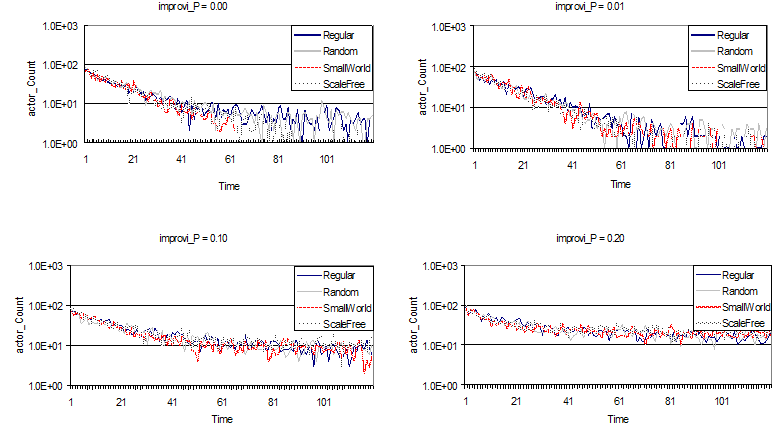
(a) The total number of individual actor agents searching for new alternatives 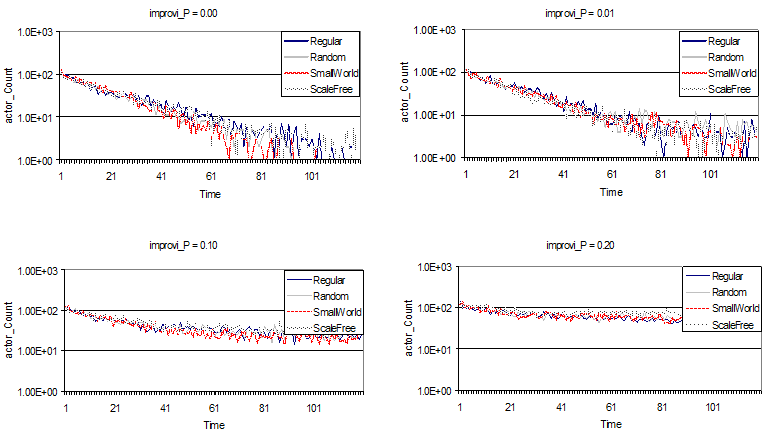
(b) The total number of individual actor agents that imitate their neighbours 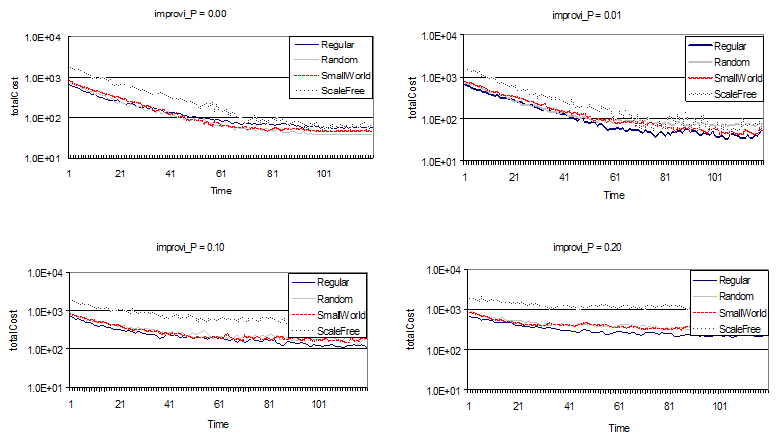
(c) Values of the coefficient totalCost 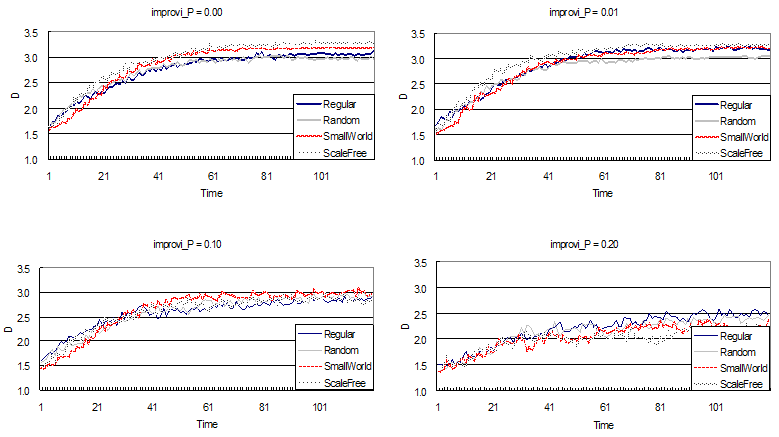
(d) Values of the coefficient D Figure 7. Simulation results with default settings for Scenario III - 4.15
- From the simulation results shown in Figure 7, we can
conclude the following:
- When individual actors involved in the routine are heterogeneous (that is, each individual actor agent has different values of both the coefficients memoryLength and actionNum), the routine system on all four network topologies is convergent and eventually reaches a stable state, as shown in the upper-left portion of Figure 7 (a) and (b). However, the routine system on scale-free networks would obtain a much higher value of the coefficient D, which represents a higher coherency and routinization level of organizational behaviours.
- If there are minor numbers of improvisations from individual actors (improvi_P = 0.01, for example), we can deduce from the upper-right portion of Figure 7 (a), (b), (c) and (d) that the routine system on all four types of network topologies can be converged over time, arriving at a relatively different yet stable state, as well. This result is in accordance with Hutchins's (1991, 1995) work on a collective manual navigation study, showing that improvisation from participants can also result in the emergence of new routines in organizations. Although there are no significant differences between these four types of network topologies, the routine system on scale-free networks obtain a much higher value of the coefficient D (which represents a higher routinization level of organizational behaviours), but expends a relatively higher value of the coefficient totalCost. Further, the routine system on random networks gains a relatively lower value of the coefficient D, indicating its sensitivity to improvisations from the individual actors involved.
- Nevertheless, with the increase of the improvisation probability value improvi_P (improvi_P = 0.10 and 0.20), there is an increase in individual actors exhibiting more individualistic manners. In such a situation, we reach the same conclusion affirmed by Weick (1990), that organizational routines may be disrupted, as shown in the bottom portion of Figure 7 (a) and (b), resulting in the higher value of the coefficient totalCost, but the lower value of the coefficient D, as shown in the bottom portion of Figure 7 (c) and (d).
 Conclusion
and discussion
Conclusion
and discussion
- 5.1
- Organizational routines are some collective phenomena in which multiple individual actors are involved. In this paper, by regarding the habitual behaviours of individual actors as elementary building blocks (Bapuji et al. 2012; Knudsen 2008), we considered organizational routines from an 'emergence-based' perspective. We emphasised the impacts of connections or network topologies among individual actors in the formation of organizational routines, and developed a multi-agent based simulation model for formally expressing and visually depicting the emerging process of organizational routines on complex networks. The conclusions of our work are as follows.
- 5.2
- First, the multiple, individual actors play fundamental roles during the formation of organizational routines. By regarding organizational routines as the emerging results of individual habits of the multiple actors involved, we observe a mutual relationship between both the ostensive and performative aspects of the routines (Feldman & Pentland 2003), and provide a comparatively new but effective approach to investigate the underlying dynamics of organizational routines at the micro-level.
- 5.3
- Second, we created a multi-agent based simulation model of organizational routines on complex networks. Our simulation results indicate that network topologies among individual actors do have significant impacts on the dynamic characteristics of organizational routines. However, their impacts on the evolutionary trajectory of the routines are closely influenced by two main factors. The first is the memory capacity of individual actors that are involved in the routines. The second is the component complexity of organizational tasks relating to the organization. Nevertheless, for all four situations with different combinations of the levels of these two factors (in this paper, we use the values of the coefficient memoryLength and actionNum to represent, respectively), we find that the organization (which constitutes a certain number of individual actors) on scale-free networks can always obtain a much higher coherency and routinization level of collective behaviours that we call organizational routines.
- 5.4
- That is, scale-free networks possess inherent superiority in shaping strong organizational routines. The reason may be that scale-free networks are beneficial for imitation activities among various individual actors, as imitation is one of the crucial mechanisms through which individual habits are transmitted (Hodgson 2008), leading to the emergence of routines at the organizational level. In addition, the impacts of network topologies on the total costs that the organization bears during the implementation of organizational tasks are variant, depending on different combinations of both the memory capacity of individual actors and the component complexity of organizational tasks that the individual actors need to deal with repetitively.
- 5.5
- Third, the turnover of individual actors may result in more fluctuations on the routine system. In such a circumstance, the routine system on scale-free networks performs significantly different from those on the other three network topologies (i.e. the regular, random, and small-world networks).
- 5.6
- Fourth, when the individual actors involved in the routine are heterogeneous, the routine system on scale-free networks exhibits a strong anti-disturbance ability, and achieves a relatively stable, higher routinization level of collective behaviours over time, regardless of whether or not there were minor improvisations from these individual actors. Nevertheless, a large number of improvisations enabled individual actors to act in more individualistic manners, which may destroy the routine system.
- 5.7
- Therefore, we confirm that the routine system should maintain a balance between the inertia resulted from individual memories, component complexity of organizational tasks, the impacts of both turnover and improvisation from the individual actors involved, and the dynamical properties of network topologies within which these individual actors are located.
- 5.8
- All of these findings could help open up the 'black box' of organizational routines that emerge from repeated interaction among individual actors, and to further investigate their formation and micro-dynamics at the micro-level. Nevertheless, we should state that our simulation results are not validated in practice. This is a rich field of research, and there are some additional significant points about the multi-agent based simulation model that could be improved upon in the future. For example: (1) Although environment changes are common occurrences for today's organizations, we only refer to organizational routines in a relatively stable environment. (2) Artifacts are not involved in our simulation model, but according to a particular set of studies (Feldman & Pentland 2003; Pentland & Feldman 2007, 2008), artifacts are one of several very important parts of organizational routines. (3) Identity of the individual actors involved is also a crucial concept in the organizational routines theory (Hutchins 1995), but is not referred to in this paper. (4) We only treat the memory capacity of individual actors as a rough concept, not identifying the distinction between different kinds of memories (i.e. procedural, declarative, and transactive (Miller et al. 2012). These would be expanded in a more complete version. In addition, field data are needed for validation of the simulation model. This may seem challenging, but could lead to more fruitful findings in future research.
 Acknowledgements
Acknowledgements
- The work for this paper is supported by National Natural Science Foundation of China (under Grant No. 71471007, 91224007 and 71302188), Beijing Natural Science Foundation (under Grant No. 9142013). Humanities and social sciences research planning project from the Education Department of Shandong Province (under Grant No. J12WF04), Youth Foundation from Shandong Institute of Business and Technology (under Grant No. 2014QN004). The authors would like to thank the editor and four anonymous reviewers for their constructive comments, which have helped us to improve the manuscript.
 Note
Note
- This manuscript is a further improved version of the work that was submitted to the 44th International Conference on Computers & Industrial Engineering (Istanbul, 14–16 October 2014)
 References
References
- AARTS, H., &
Dijksterhuis, A. (2000). Habits as knowledge structures: automaticity
in goal-directed behavior. Journal of Personality and Social
Psychology, 78(1):53–63 [doi:10.1037/0022-3514.78.1.53]
ABELL, P., Felin, T., & Foss, N. J. (2008). Building micro-foundations for the routines, capabilities, and performance links. Managerial and Decision Economics, 29(6): 489–520 [doi:10.1002/mde.1413]
BARABÂSI, A. L., Albert, R. & Jeong, H. (1999). Mean-field theory for scale free random networks. Physica A, 272(1):173–187 [doi:10.1016/S0378-4371(99)00291-5]
BARABÂSI, A. L., & Bonabeau, E. (2003). Scale-free networks. Scientific American, 288(5):60–69 [doi:10.1038/scientificamerican0503-60]
BAPUJI, H., Hora, M., & Saeed, A. M. (2012). Intentions, intermediaries, and interaction: examining the emergence of routines. Journal of Management Studies, 49(8):1586-1607 [doi:10.1111/j.1467-6486.2012.01063.x]
BECKER, M. C. (2004). Organizational routines: a review of the literature. Industrial and Corporate Change, 13(4):643–677 [doi:10.1093/icc/dth026]
BECKER, M. C. (2005). The concept of routines: some clarifications. Cambridge Journal of Economics, 29(2):249–262 [doi:10.1093/cje/bei031]
COHEN, M. D., & Bacdayan, P. (1994). Organizational routines are stored as procedural memory: evidence from a laboratory study. Organization Science, 5(4):554–568 [doi:10.1287/orsc.5.4.554]
COHENDET, P., & Llerena, P. (2003). Routines and incentives: the role of communities in the firm. Industrial and Corporate Change, 12(2):217–297 [doi:10.1093/icc/12.2.271]
DOROGOVTSEV, S. N., & Mendes, J. F. F. (2003). Evolution of Networks: From Biological Nets to the Internet and WWW. Oxford: Oxford University Press
ERDÖS, P., & Rényi, A. (1959). On random graphs. Publicationes Mathematicae (Debrecen), 6:290–297
FELDMAN, M. S. (2000). Organizational routines as a source of continuous change. Organization Science, 11(6): 611–629 [doi:10.1287/orsc.11.6.611.12529]
FELDMAN, M. S., & Pentland, B. T. (2003). Reconceptualizing organizational routines as a source of flexibility and change. Administrative Science Quarterly, 48(1): 94–118 [doi:10.2307/3556620]
FELDMAN, M. S., & Rafaeli, A. (2002). Organizational routines as sources of connections and understandings. Journal of Management Studies, 39(3):309–331 [doi:10.1111/1467-6486.00294]
FELIN, T., Foss, N. J., Heimeriks, K. H., & Madsen, T. L. (2012). Microfoundations of routines and capabilities: individuals, processes, and structure. Journal of Management Studies, 49(8):1351–1374 [doi:10.1111/j.1467-6486.2012.01052.x]
GAO,D., Deng, X., & Bai, B. (2014). The emergence of organizational routines from habitual behaviours of multiple actors: an agent-based simulation study. Journal of Simulation, 8(3):215-230 [doi:10.1057/jos.2014.1]
GILBERT, C. G. (2005). Unbundling the structure of inertia: Resource versus routine rigidity. Academy of Management Journal, 48(5):741–763 [doi:10.5465/AMJ.2005.18803920]
GILBERT, N. (2008). Agent-Based Models, London: Sage Publications
GRAVE, H. (2008). Organizational routines and performance feedback. In: Becker, M. C. (ed.), Handbook of Organizational Routines, Edward Elgar: Cheltenham, 187–205 [doi:10.4337/9781848442702.00016]
GROTE, G, Weichbrodt, J. C., Günter, H., Zala-Mezö, E., & Künzle B. (2009). Coordination in high-risk organizations: the need for flexible routines. Cognition, Technology & Work, 11(1):17–27 [doi:10.1007/s10111-008-0119-y]
HENDRICKS, W. O. (1972). The structure study of narration: Sample analyses. Poetics, 1(3):100–123 [doi:10.1016/0304-422X(72)90040-X]
HENDRICKS, W. O. (1973). Methodology of Narrative structural analysis. Semiotica, 7(2):163–184 [doi:10.1515/semi.1973.7.2.163]
HODGSON, G. M. (2008). The concept of a routine. In Becker, M. C. (ed.), Handbook of Organizational Routines, Edward Elgar: Cheltenham, 15–30 [doi:10.4337/9781848442702.00007]
HODGSON, G. M., & Knudsen, T. (2004). The complex evolution of a simple traffic convention: the functions and implications of habit. Journal of Economic Behavior & Organization, 54(1):19–47 [doi:10.1016/j.jebo.2003.04.001]
HOWARD-GRENVILLE, J. A. (2005). The persistence of flexible organizational routines: the role of agency and organizational context. Organization Science, 16(6):618–636 [doi:10.1287/orsc.1050.0150]
HUTCHINS, E. (1991). Organizing work by adaptation. Organization Science, 2(1):14–39 [doi:10.1287/orsc.2.1.14]
HUTCHINS, E. (1995). Cognition in The Wild, Massachusetts: The MIT Press
JEONG, H. (2003). Complex scale-free networks. Physica A, 321:226–237 [doi:10.1016/S0378-4371(02)01774-0]
KNUDSEN, T. (2008). Organizational routines in evolutionary theory. In Becker, M. C. (ed.), Handbook of Organizational Routines, Edward Elgar: Cheltenham, 125–151 [doi:10.4337/9781848442702.00014]
KOZICA, A., Kaiser, S., & Friesl, M. (2014). Organizational routines: conventions as a source of change and stability. Schmalenbach Business Review, 66(3):334–356
LAZARIC, N. (2008). Routines and routinization: an exploration of some micro-cognitive foundations. In: Becker, M. C. (ed.), Handbook of Organizational Routines, Cheltenham: Edward Elgar, 205–227 [doi:10.4337/9781848442702.00017]
MILGRAM, S. (1967). The small world problem. Psychology Today, 2: 60-67
MILLER, K. D., Pentland, B. T., & Choi, S. (2012). Dynamics of performing and remembering organizational routines. Journal of Management Studies, 49(8):1536–1558 [doi:10.1111/j.1467-6486.2012.01062.x]
NORTH, M. J., & Macal, C. M. (2007). Managing Business Complexity: Discovering Strategic Solutions with Agent-based Modeling and Simulation, Oxford University Press: New York
PENTLAND, B. T. (2003). Conceptualizing and measuring variety in the execution of organizational work process. Management Science, 49(7): 857–870 [doi:10.1287/mnsc.49.7.857.16382]
PENTLAND, B. T., & Feldman, M. S. (2005). Organizational routines as a unit of analysis. Industrial and Corporate Change, 14(5):793–815 [doi:10.1093/icc/dth070]
PENTLAND, B. T., & Feldman, M. S. (2007). Narrative networks: patterns of technology and organization. Organization Science, 18(5):781–795 [doi:10.1287/orsc.1070.0283]
PENTLAND, B. T., & Feldman, M. S. (2008). Designing routines: on the folly of designing artifacts, while hoping for patterns of action. Information and Organization, 18(4):235–250 [doi:10.1016/j.infoandorg.2008.08.001]
PENTLAND, B. T., Hærem, T., & Hillison, D. (2010). Comparing organizational routines as recurrent patterns of action. Organization Studies, 31(7):917–940 [doi:10.1177/0170840610373200]
POSTREL, S., & Rumelt, R. P. (1996). Incentives, routines and self-command. In Dosi, G., & Malerba, F. (ed.), Organization and Stragety in the Evolution of the Enterprise, Basingstoke and London: Macmillan Press Ltd, 72–102 [doi:10.1007/978-1-349-13389-5_4]
SCHULZ, M. (2008). Staying on track: a voyage to the internal mechanisms of routine reproduction. In: Becker, M. C. (ed.), Handbook of Organizational Routines, Edward Elgar: Cheltenham, 228–255 [doi:10.4337/9781848442702.00018]
SIMON, H. (1945). Administrative Behavior, New York: Free Press
SWARM DEVELOPMENT GROUP [SDG]. (2000). A tutorial introduction to Swarm, http://www.swarm.org , accessed 15 October 2009
TURNER, S. F., & Fern, M. J. (2012). Examining the stability and variability of routine performances: the effects of experience and context change. Journal of management Studies, 49(8):1407–1434 [doi:10.1111/j.1467-6486.2012.01061.x]
TURNER, S. F., & Rindova, V. (2012). A balancing act: How organizations pursue consistency in routine functioning in the face of ongoing change. Organization Science, 23(1):24–46 [doi:10.1287/orsc.1110.0653]
WANG, X. F., & Chen, G. (2003). Complex networks: small-world, scale-free and beyond. Circuits and Systems Magazine, IEEE, 3(1):6–20 [doi:10.1109/MCAS.2003.1228503]
WATTS, D. J. (1999). Small Worlds: The Dynamics of Networks between Order and Randomness, Princeton University Press
WATTS, D. J., & Stogatz, S. H. (1998). Collective dynamics of "small-world" networks. Nature, 393:440–441 [doi:10.1038/30918]
WEICK, K. E. (1990). The vulnerable system: an analysis of the Tenerife air disaster. Journal of Management, 16(3):571–593 [doi:10.1177/014920639001600304]
WINTER, S. G. (2003). Understanding dynamic capabilities. Strategic Management Journal, 24(10):991–995 [doi:10.1002/smj.318]
WITT, U. (2011). Emergence and functionality of organizational routines: an individualistic approach. Journal of Institutional Economics, 7(2):157–174 [doi:10.1017/S1744137410000226]
WOOD, R. E. (1986). Task complexity: Definition of the construct. Organizational Behavior and Human Decision Processes, 37(1):60–82 [doi:10.1016/0749-5978(86)90044-0]
WOOD, W., & Neal, D. T. (2007). A new look at habits and the interface between habits and goals. Psychological Review, 114(4):843–863 [doi:10.1037/0033-295X.114.4.843]
YIN, H. H., Knowlton, B. J., & Balleine, B. W. (2004). Lesions of dorslateral striatum preserve outcome expectancy but disrupt habit formation in instrumental learning. European Journal of Neuroscience, 19(1):181–189 [doi:10.1111/j.1460-9568.2004.03095.x]
